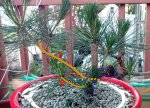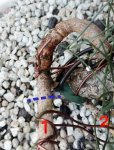pitchpine
Mame
Hey guys,
Backstory: a couple years ago I tried an approach graft on my first Japanese black pine, which was a workshop tree and still early in development. My goal was to improve the lower trunk, which due to some twists looks like it has a bit of reverse taper even though it doesn't really. So I grafted the lowest branch (#1 on the photo), which was in a poor location on an inside curve, around to the opposite side and in a lower position. This spring I realized the graft had failed because I made the cut too shallow and didn't secure the branch tightly enough, and as it thickened it got pushed completely out.
So I recently decided to try again at a slightly lower point on the trunk (green circle on the photo) using a small side shoot of the original donor branch (#2 on the photo). I'm pretty sure this time I made the cut deep enough and nailed the scion securely in place. (FYI, the dashed lines show the parts of the branch that are behind the trunk from the viewpoint of the photo.)
I know I want to prune the original branch back to the grafted offshoot, but am uncertain as to the proper timing. If I want to maximize both the chances of the graft taking and the speed at which it does, should I cut #1 back to the juncture with #2 all at once, or in stages? And should I make the first (or total) cut now, or wait for the needles to harden off?
Thanks in advance for any advice!
Laura
Backstory: a couple years ago I tried an approach graft on my first Japanese black pine, which was a workshop tree and still early in development. My goal was to improve the lower trunk, which due to some twists looks like it has a bit of reverse taper even though it doesn't really. So I grafted the lowest branch (#1 on the photo), which was in a poor location on an inside curve, around to the opposite side and in a lower position. This spring I realized the graft had failed because I made the cut too shallow and didn't secure the branch tightly enough, and as it thickened it got pushed completely out.
So I recently decided to try again at a slightly lower point on the trunk (green circle on the photo) using a small side shoot of the original donor branch (#2 on the photo). I'm pretty sure this time I made the cut deep enough and nailed the scion securely in place. (FYI, the dashed lines show the parts of the branch that are behind the trunk from the viewpoint of the photo.)
I know I want to prune the original branch back to the grafted offshoot, but am uncertain as to the proper timing. If I want to maximize both the chances of the graft taking and the speed at which it does, should I cut #1 back to the juncture with #2 all at once, or in stages? And should I make the first (or total) cut now, or wait for the needles to harden off?
Thanks in advance for any advice!
Laura


